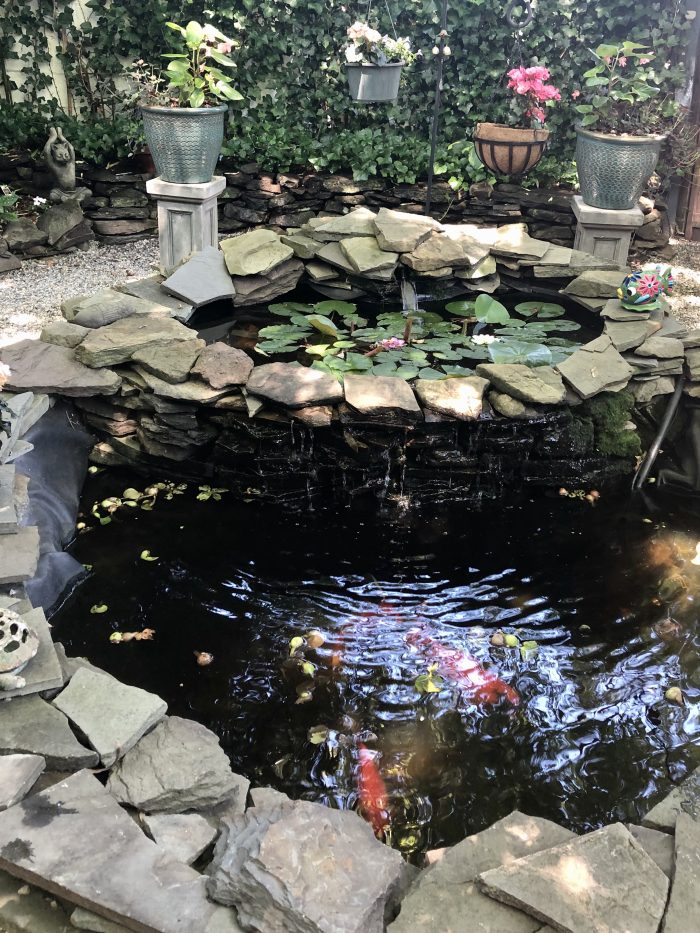“Remember, the entrance door to the sanctuary is inside you.” ~ Rumi, Sufi poet and mystic
~
When my husband and I first saw our 1850s Victorian, we fell in love with it immediately.
It helped that it was a summer-like day in the middle of a Northeast winter, and that the small town where it was located was so unlike the busy suburbia we were used to.
The house itself had been lovingly restored, although allowed enough room for our own stamp. When we entered the backyard, however, a different sight awaited: rotting wood beds, a bamboo fence that was barely standing, a blank patch in the middle of the yard containing an abstract sculpture we hated.
While slightly daunted by the work it would take to make the backyard our own, we started blending the garden of the past with the new. A shady patch of bamboo honored the old fence, now home to our Buddha and meditating cat, symbols that are special to us. Stones replaced the rotting wood, plants began to flourish in the new beds. And yet, in the center of what was to become our sanctuary, a hole remained.
That’s the way it is with sanctuary sometimes. It takes time to build and to fill the holes.
I know this well, a lesson taught to me by the many people I’ve worked with as a therapist. When we first meet, many describe themselves as “broken.” And while the scars left by past traumas can heal, it takes time. It takes connecting with the past, honoring the wounded parts, and believing that the new can be even more beautiful.
In Japan, there is the tradition of Kintsugi, the art of precious scars. When a piece of pottery breaks, skilled artists mend the pottery with gold or other precious metals. The piece is considered even more beautiful because of its now golden brokenness.
It was to Japan we also turned for inspiration, deciding to complete our backyard sanctuary with a koi pond. We worked on this for many, many weekends, digging the hole by hand, and deep enough to protect the koi from our harsh winters. We then placed each stone in a circle, adding a second level waterfall so that the koi would have a steady flow of life-giving oxygen. Water lilies in the top pond flowered, and we soon welcomed the koi that would grow to the perfect size for our small pond. Even now, the pond and koi need our care and attention, a labor of love.
In addition to the beauty I find there, our backyard is also a sanctuary, both sacred and safe. When I sit by the pond and watch the playful fish, I feel calm. It is a place where I feel completely embodied, centered, and at peace. When not there physically, I can imagine the sound of the waterfall, feel the cool of the shade, and smell the scents of spring.
We all need sanctuary at times. Certainly the past months have shown us how important that is. And while I am lucky enough to have my sanctuary quite literally outside of my door, we can create an inner sanctuary, as Rumi suggests.
What is an Inner Sanctuary and Why Create One?
Just as my koi garden is that place I can go when things in the world start to get hectic, an inner sanctuary is a place of calm. This internal representation helps us to feel safe, and visualizing it when things get tough is a natural buffer.
Building an outer sanctuary takes time, and developing these inner resources does as well. While some of us—especially frequent meditators—can just close our eyes and imagine ourselves in our garden, at the beach, or walking through nature and feel immediately refreshed, most of us need to first actively create this inner space and practice returning to it. This can enhance our emotional well-being.
Rumi has another famous poem in which he says that humans are like guest houses and the visitors are our emotions. Just as business owners can’t turn away all their challenging customers or they would quickly go under, we need to learn to welcome even difficult emotions such as sadness, anger, or depression.
We each have an internal zone in which difficult emotions can more easily roll off. The fancy name for that is our “window of tolerance.” When faced with difficult life situations, this window can become smaller. For instance, when you’ve had a hard day in the office, a whining child may provoke a stronger response than on a less stressful day. For people who have had chronic traumas, such as childhood abuse, these windows of tolerance become even smaller.
When we are outside of this window, we can feel either numbed out or on overdrive. While both are challenging, heightened feelings can be especially hard. “Heightened” can feel like fight-or-flight, a racing heart, shortness of breath, or irritability. These are body-based feelings and can make it hard to provide that welcome that Rumi suggests.
When in overdrive, it’s tempting to try to suppress emotions, and this can become a habit. For instance, that glass (or two or three) of wine may be a way to chill out, and while it “works,” it can lead to its own set of problems.
When we have those inner places we can go to, rather than reaching for a glass of Chardonnay or chocolate bar, it’s easier to shrug off problems and return to calm and equilibrium.
The Process of Creating an Inner Sanctuary.
The process of creating an inner sanctuary takes time, just as my garden took time to shape. Some people find that creating an inner sanctuary works best by listening to a visualization. That can be helpful. You can also guide yourself.
Begin with thinking about what safe and calm feels like. When you have had experiences of peace, where have you been? What places remind you of this feeling? Perhaps it’s a place in nature, like my own. Our natural world seems to evoke particularly strong and positive feelings.
When you have an idea of what this place may be, settle in and rest your hands on your heart center. In your mind’s eye, explore how your senses become alive as you imagine this place. What do you see? Hear? Feel? Smell? Taste? As these impressions come, you may notice that you feel calm and at ease. The first couple times you visit this inner sanctuary, jot your impressions down in your journal. This allows for your healing place to become more complex and vivid as it develops within you.
The best part about having an inner sanctuary is that it’s always with you, no matter the season or your setting. In returning there we can experience true serenity.








Read 0 comments and reply